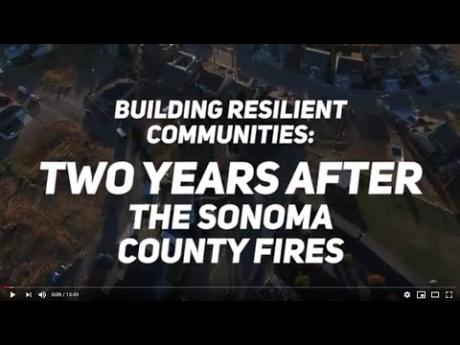The Rise of Resiliency: CSAC, Sonoma County Hosts Wildfire Related Regional Meeting
October 11, 2019
Two years ago, the North Bay fires forever changed the landscape of Sonoma County. Wildfire and disaster prevention and recovery became, and remain, key legislative priorities for CSAC. On the anniversary of the fires, nearly 70 attendees from 14 counties were expected to visit Sonoma County for a regional meeting, The Rise of Resiliency — Practical Information on Mitigation & Preparedness.
Hosted by Sonoma County Supervisor and CSAC 2nd Vice President, James Gore, the CSAC regional meeting coincided with an extensive PGE Public Safety Power Shutoff (PSPS). In Sonoma County alone, 200,000 residents — about 40 percent of the population — were without power. With that reminder of California’s “new normal,” the two-day regional meeting kicked off with an afternoon tour of Sonoma County neighborhoods impacted by the 2017 fire storm. Representatives from Coffey Strong shared how their efforts working together enabled progress resulting in home rebuilds that are well under way to complete.
An evening educational session, reception and dinner provided distinguished guests, including first responders and fire survivors, the chance to reminisce and reflect through shared stories of recovery and resiliency. Karen Gaffney from Sonoma County Ag & Open Spaces and Lisa Michelli from Pepperwood Preserve shared how working together to understand fire ecology and the local watershed are helping to plan a more resilient future. More information is available at https://www.pepperwoodpreserve.org/livingwithfire/
Alma Bowen, a Sonoma County 9-1-1 operator the night of the fires, was recognized by CSAC at the dinner. Her experiences that night helped Bowen realize that local communities needed more assistance to reach under-served residents adequately, including the Spanish-speaking population and low-income seniors in emergencies. As a result, Bowen founded Nuestra Comunidad, a non-profit organization that provides trainings in Spanish and English to share vital information to improve emergency response with local jurisdictions, first responders and community members.
The evening’s events capped off with local fire survivors and block captains sharing their experiences and lessons learned during rebuilding. Their stories were poignant and pointed, with requests and recommendations for policy changes to make rebuilding easier.
The Rise of Resiliency Practical Information on Mitigation & Preparedness (Day Two)
“Wildfires have the possibility of impacting every California county, and certainly every California county is vulnerable to emergencies,” said CSAC President and Humboldt County Supervisor Virginia Bass at the opening of Thursday’s session. “Certainly we’re getting some real life practice on what we need to prepare for and improve in our communities in light of this week’s PSPS.” Indeed, while a handful of the confirmed speakers were unable to attend, robust presentations and interactive dialogue characterized the day’s events.
The first panel of the day featured Tim Dawson, Senior Engineering Geologist for the California Geological Survey, and David Rabbit, Chairman of the Sonoma County Board of Supervisors, with moderation by Supervisor Gore regarding “Identifying Risk and Increasing Statewide Resiliency.” Expanding the focus of emergencies beyond wildfires, this panel focused on how maps and data can aid facilities planning, structural design and hardening to withstand disasters like earthquakes and tsunamis.
“The fires were hell on earth, just incredible to go through,” said Chairman Rabbit. “But if we have a significant earthquake, the response will be even more widespread and change what we’ll have to go through.”
Orange County Supervisor and CSAC 1st Vice President Lisa Bartlett presented the next discussion topic, “Disaster Mitigation & Resiliency Funding Strategies.” The featured speaker was Colin Vissering, Managing Director of Preparedness, Hazard Mitigation and Resilience with Witt O’Brien’s, a crisis and emergency management firm. A nationally recognized expert with over 25 years of specialization in pre-disaster planning, hazard mitigation, environmental consulting, urban planning and historic preservation, Vissering shared the landscape of existing and emerging resources for counties and provided the group and excellent breakdown of available funding programs from the federal government and strategies to make grant applications more successful.
While the day wrapped up with lively roundtable discussions, the final panel of the day focused on Sonoma County’s Top 10 List for Resiliency. A distinguished panel of Sonoma County staff shared the multifactorial efforts – from behavioral health strategies to an enhanced alert and warning program to the creation of an emergency management director position to enhance recovery, build resiliency and prepare for future events.
“Having a plan does make a difference,” said Michael Gossman, Deputy County Administrator for the Sonoma County Office of Recovery and Resiliency.
“There’s got to be a culture of shared learning,” said Grant Davis, General Manager of Sonoma Water. “We learned from San Diego. We planned Sonoma Ready Day by learning from San Mateo. I hope next year us our year of resiliency.”
There were many resources and lessons learned shared by participants throughout the meeting. PowerPoint presentations and videos from this Regional Meeting will be available the CSAC website at http://www.counties.org in the near future.
“The only progress is imperfect, relentless progress,” said Supervisor Gore. “We went from fire victims to fire supervisors to fire thrivers.”











































